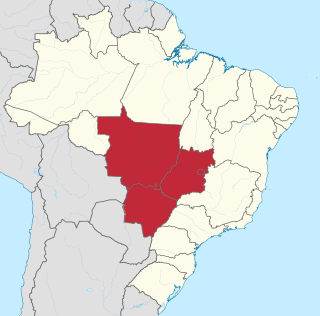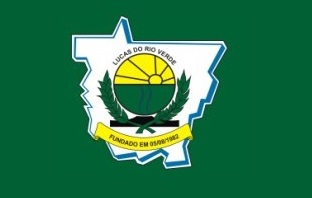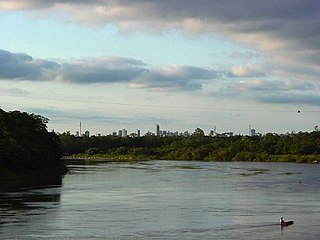
Mato Grosso is one of the states of Brazil, the third largest by area, located in the Central-West region. The state has 1.66% of the Brazilian population and is responsible for 1.9% of the Brazilian GDP.

Mato Grosso do Sul is one of Brazil's 27 federal units, located in the southern part of the Central-West Region, bordering five Brazilian states: Mato Grosso, Goiás and Minas Gerais (northeast), São Paulo (east) and Paraná (southeast); and two South American countries: Paraguay and Bolivia (west). It is divided into 79 municipalities and covers an area of 357,145.532 square kilometers, which is about the same size as Germany. With a population of 2,839,188 inhabitants in 2021, Mato Grosso do Sul is the 21st most populous state in Brazil.

The Pantanal is a natural region encompassing the world's largest tropical wetland area, and the world's largest flooded grasslands. It is located mostly within the Brazilian state of Mato Grosso do Sul, but it extends into Mato Grosso and portions of Bolivia and Paraguay. It sprawls over an area estimated at between 140,000 and 195,000 km2. Various subregional ecosystems exist, each with distinct hydrological, geological, and ecological characteristics; up to 12 of them have been defined.

The Central-West or Center-West Region of Brazil is composed of the states of Goiás, Mato Grosso and Mato Grosso do Sul; along with Distrito Federal, where Brazil's national capital, Brasília, is situated. The region comprises 18.86% of the national territory, and is the least populated in Brazil.

Sinop is a city in the Brazilian state of Mato Grosso. The fourth-largest city in the state, its population in 2022 is estimated at 196,312 inhabitants, placing Sinop in 155th place in Brazil. It has an area of 3194.339 km². A Sivam radar has been installed for monitoring the Amazon Basin. Also Embrapa has a branch in Sinop, the only one in the state of Mato Grosso. It is known as the Capital of Nortão, a major city of northern Mato Grosso.

The Mato Grosso campaign was an early Paraguayan offensive in the Paraguayan War. Paraguay invaded the Brazilian province of Mato Grosso.

Aporé is a municipality in southwest Goiás state, Brazil. The municipality is a large producer of cattle. Aporé belongs to the Southwest Goiás Microregion.

Time in Brazil is calculated using standard time, and the country is divided into four standard time zones: UTC−02:00, UTC−03:00, UTC−04:00 and UTC−05:00.

BR-163 is a highway in Brazil, going from Tenente Portela, in the state of Rio Grande do Sul, to Santarém, Pará, on 3579 kilometers. It was proposed to pave the road in its entirety part of the Avança Brasil project, which in 2007 was replaced by the Programa de Aceleração do Crescimento. A 51 km long stretch of the highway was finally paved in 2019 in the state of Pará in a cooperation between the Bolsonaro government and the Brazilian army engineering battalion, until the city of Miritituba, leaving only a small part of the highway to be paved on the other side of the Amazon River.

The city of Lucas do Rio Verde is located in the Brazilian state of Mato Grosso, 220 miles north of the state capital, Cuiabá. It has an area of 3,675 km² and a population of 83.798. Lucas do Rio Verde is one of Brazil's major agricultural cities. The city is served by Bom Futuro Airport.

Vila Bela da Santíssima Trindade is a Brazilian municipality in Mato Grosso with 16,271 (2020) inhabitants. It is located at upper Guaporé River close to the border with Bolivia. The municipality was founded by Dom Antônio Rolim de Moura Tavares (1709-1782), the first governor of the Captaincy of Mato Grosso, to serve as the capital of the new captaincy.

The Cuiabá River is a Brazilian river in the western state of Mato Grosso that flows in the Río de la Plata Basin. It is a tributary of the São Lourenço River.

The Nambikwaran languages are a language family of half a dozen languages, all spoken in the state of Mato Grosso in Brazil. They have traditionally been considered dialects of a single language, but at least three of them are mutually unintelligible.

The Ramarama languages of Rondônia, Brazil form a branch of the Tupian language family. They are Karo, or Ramarama, with 150 speakers, and the extinct Urumi.

The Ofayé or Opaye language, also Ofaié-Xavante, Opaié-Shavante, forms its own branch of the Macro-Jê languages. It is spoken by only a couple of the small Ofayé people, though language revitalization efforts are underway. Grammatical descriptions have been made by the Pankararú linguist Maria das Dores de Oliveira (Pankararu), as well as by Sarah C. Gudschinsky and Jennifer E. da Silva, from the Universidade Federal do Mato Grosso do Sul.

The Piquirí River is a river of Mato Grosso state in western Brazil. It is a tributary of the São Lourenço River.
The Culuene Biological Reserve is a biological reserve in the state of Mato Grosso, Brazil. It protects an area of cerrado forest in contact with seasonal deciduous forest on the left (west) bank of the Culuene River.

















